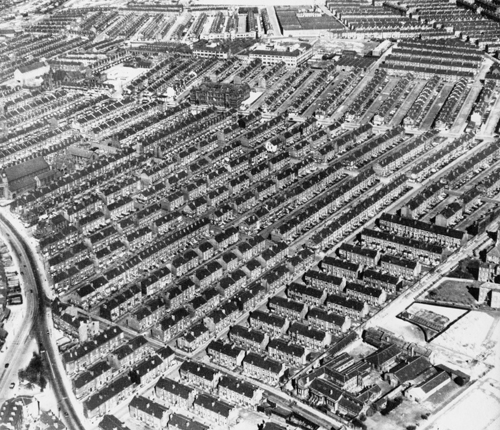Back-to-back housing
Back-to-back housing is a form of terraced housing in which two houses share a rear wall. With the rapid expansion of the population in Victorian Britain’s factory towns during the Industrial Revolution, many thousands of back-to-back houses were built.
They were typically occupied by working class people and were generally of low quality and high density. The houses were usually either ‘two-up-two-down’ (i.e. two rooms on both floors), or one room on each of three floors.
Because three of the four walls were shared with other buildings, this type of housing suffered from poor illumination and ventilation. However, they did have some benefits, such as being cheap to build and inexpensive to rent, as well as delivering high-density while giving people their own home as opposed to a flat.
Back-to-back housing was eventually judged to be unsatisfactory and the Housing Act of 1909 outlawed further construction. However, some local authorities continued to sanction their construction until the late-1930s.
Back-to-back housing was particularly common in the inner city areas of Birmingham, Bradford, Leeds, Liverpool, Salford and Nottingham. Only small areas of the housing still exists, most notably in Birmingham where they have been preserved as a museum by the National Trust.
[edit] Find out more
[edit] Related articles on Designing Buildings Wiki
Featured articles and news
RTPI leader to become new CIOB Chief Executive Officer
Dr Victoria Hills MRTPI, FICE to take over after Caroline Gumble’s departure.
Social and affordable housing, a long term plan for delivery
The “Delivering a Decade of Renewal for Social and Affordable Housing” strategy sets out future path.
A change to adoptive architecture
Effects of global weather warming on architectural detailing, material choice and human interaction.
The proposed publicly owned and backed subsidiary of Homes England, to facilitate new homes.
How big is the problem and what can we do to mitigate the effects?
Overheating guidance and tools for building designers
A number of cool guides to help with the heat.
The UK's Modern Industrial Strategy: A 10 year plan
Previous consultation criticism, current key elements and general support with some persisting reservations.
Building Safety Regulator reforms
New roles, new staff and a new fast track service pave the way for a single construction regulator.
Architectural Technologist CPDs and Communications
CIAT CPD… and how you can do it!
Cooling centres and cool spaces
Managing extreme heat in cities by directing the public to places for heat stress relief and water sources.
Winter gardens: A brief history and warm variations
Extending the season with glass in different forms and terms.
Restoring Great Yarmouth's Winter Gardens
Transforming one of the least sustainable constructions imaginable.
Construction Skills Mission Board launch sector drive
Newly formed government and industry collaboration set strategy for recruiting an additional 100,000 construction workers a year.
New Architects Code comes into effect in September 2025
ARB Architects Code of Conduct and Practice available with ongoing consultation regarding guidance.
Welsh Skills Body (Medr) launches ambitious plan
The new skills body brings together funding and regulation of tertiary education and research for the devolved nation.
Paul Gandy FCIOB announced as next CIOB President
Former Tilbury Douglas CEO takes helm.
UK Infrastructure: A 10 Year Strategy. In brief with reactions
With the National Infrastructure and Service Transformation Authority (NISTA).























